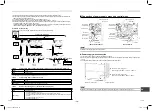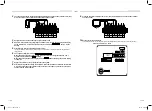
– 8 –
15-EN
16-EN
EN
FR
7
Refrigerant piping
WARNING
•
If the refrigerant gas leaks during installation, ventilate the room.
If the leaked refrigerant gas comes into contact with
fi
re, noxious gas may be generated.
•
After installation, check that the refrigerant gas does not leak.
If the refrigerant gas leaks into the room and comes into contact with
fi
re such as a fan heater, stove, or
kitchen range, noxious gas may be generated.
■
Connection of refrigerant pipe
• The service valves are inside the outdoor unit. To
access them, remove the front panel and the piping/
wiring panel. (M5: 9 pcs.)
• As shown in the illustration on the right, the hooks
are at the right and left sides of the front panel. Lift
up and remove the front panel.
• Pipes can be drawn out forward or downward from the
outdoor unit.
• To draw out the pipe forward, draw it out to the
outside via the piping/wiring panel, and leave a space
of 19.7" (500mm) or more from the main pipe
connecting the outdoor unit with the indoor unit,
considering service work or other work on the unit.
(For replacing the compressor, 19.7" (500mm)
or more space is required.)
• To draw out the pipe downward, remove the
knockouts on the base plate of the outdoor unit, draw
the pipes out of the outdoor unit, and perform piping on the right/left or rear side. Downward length of the balance
pipe should be 16.4 ft (5m) or less.
Ball valve of suction gas side
Ball valve of suction gas side
Ball valve of suction gas side
Ball valve of
discharge gas pipe
Ball valve of
discharge gas pipe
Ball valve of
discharge gas pipe
(MAP072)
(MAP096, 120)
(MAP144, 168)
Packed valve of liquid side
Packed valve of liquid side
Packed valve of liquid side
Packed valve of
balance pipe
Packed valve of
balance pipe
Packed valve of
balance pipe
REQUIREMENT
• For a brazing work of the refrigerant pipes, be sure to use nitrogen gas in order to prevent oxidation of the inside
of the pipes; otherwise clogging of the refrigerating cycle due to oxidized scale may occur.
• Use clean and new pipes for the refrigerant pipes and perform piping work so that water or dust does not
contaminate the refrigerant.
• Be sure to use two spanners to loosen or tighten the
fl
are nut. If a single spanner is used, the required level of
tightening cannot be obtained. Tighten the
fl
are nut with the speci
fi
ed torque. (If it is hard to loosen or tighten the
fl
are nut of the balance pipe or packed valve of the liquid side with two spanners, loosen or tighten the
fl
are nut
while holding the valve mounting plate with a spanner.)
Ball valve of discharge gas side
Do not clamp the service port
with two spanners, doing so may
damage the service port.
Do not apply refrigerating oil to the surface of
the flare.
Unit: ft•lbs (N•m)
Outer dia. of
copper pipe
Tightening torque
Ø1/4 (6.4 mm)
10 to 13 (14 to 18)
Ø3/8 (9.5 mm)
24 to 31 (33 to 42)
Ø1/2 (12.7 mm)
37 to 46 (50 to 62)
Ø5/8 (15.9 mm)
50 to 60 (68 to 82)
Ø3/4 (19.1 mm)
74 to 88 (100 to 120)
Pipe connection method (Example)
Draw-out forward
Draw-out downward
Suction-side gas
pipe
Cut the L-shaped pipe, then braze the
socket procured locally.
Suction-side gas
pipe
Cut the L-shaped pipe, then braze the
socket procured locally.
Discharge-side
gas pipe
Braze the supplied attachment pipe
and elbow procured locally.
Discharge-side
gas pipe
Braze the supplied attachment pipe
and socket procured locally.
Liquid pipe
Braze the supplied attachment pipe
and socket procured locally.
Liquid pipe
Braze the supplied attachment pipe
and socket procured locally.
Balance
pipe
Discharge-side
gas pipe
L-shaped
pipe
Suction-side
gas pipe
Pipe
Pipe
Pipe
Pipe
Socket
Socket
Elbow
Attachment
pipe
Attachment
pipe
Liquid pipe
Section
to be cut
Suction-side
gas pipe
Balance
pipe
Discharge-side
gas pipe
L-shaped
pipe
Suction-side
gas pipe
Pipe
Pipe
Pipe
Pipe
Socket
Socket
Socket
Attachment
pipe
Attachment
pipe
Liquid pipe
Section
to be cut
Suction-side
gas pipe
Hook
Front panel
Piping/wiring panel
(Rear piping)
(Right piping)
(Right
piping)
(Left piping)
(Left
piping)
19.7" (500mm)
or more
Drawing out forward
Drawing out
downward
1122001101_EN FR.indd 8
1122001101_EN FR.indd 8
6/27/16 4:58 PM
6/27/16 4:58 PM
•
After installation, check that the refrigerant gas does not leak.
If the refrigerant gas leaks into the room and comes into contact with fire such as a fan heater, stove, or
kitchen range, noxious gas may be generated.









































